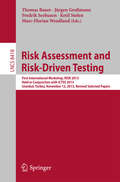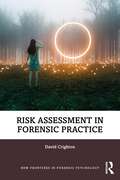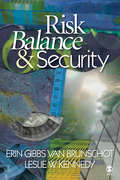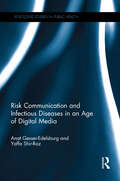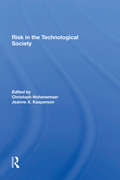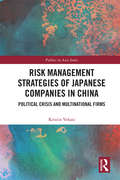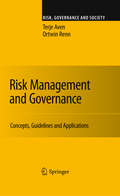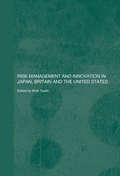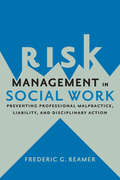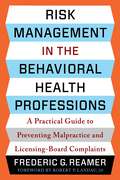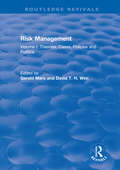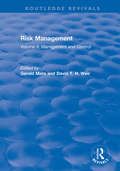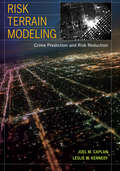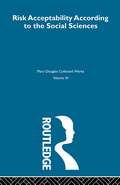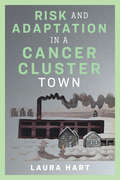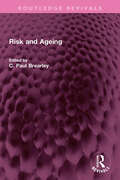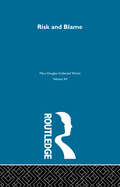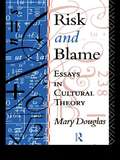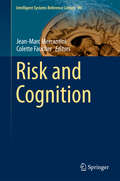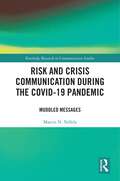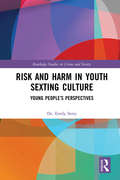- Table View
- List View
Risk Assessment and Risk-Driven Testing
by Thomas Bauer Fredrik Seehusen Jürgen Großmann Marc-Florian Wendland Ketil StølenThis book constitutes the thoroughly refereed conference proceedings of the First International Workshop on Risk Assessment and Risk-driven Testing, RISK 2013, held in conjunction with 25th IFIP International Conference on Testing Software and Systems, ICTSS 2013, in Istanbul, Turkey, in November 2013. The revised full papers were carefully reviewed and selected from 13 submissions. The papers are organized in topical sections on risk analysis, risk modeling and risk-based testing.
Risk Assessment for Juvenile Violent Offending
by Andreas Kapardis Anna Costanza BaldryThis volume is the result of an EU project involving two different European countries (Italy and Cyprus) on risk and needs assessment for juvenile violent offenders. The book is based on a longitudinal data base of juveniles who have committed violent crimes and who have been followed up after six months to measure their recidivism rate. The aim of this book is to provide practitioners who are dealing with juvenile (violent) offenders, with scientifically-based theories and knowledge derived from results about risk assessment. In particular it shows how a newly developed and tested instrument/approach, the EARN (European Assessment of Risk and Needs) works and how it can be used to help practitioners. Recidivism of violence in juveniles is based on several risk factors and is reduced on the basis of protective factors. Efficient legal intervention and treatment are more and more tailored according to the risk factors but also to the needs of juveniles. Juvenile Justice Systems in Europe tend to approach the juvenile who has committed a crime not only from a sanction point of view but more as an opportunity for the juvenile, his or her family and the social context in general, to reduce the risk of recidivism. This book will be of interest to researchers, students, social workers, police officers and lawyers.
Risk Assessment for Object Conservation
by Jonathan Ashley-Smith'Risk Assessment for Object Conservation' reflects Dr Jonathan Ashley-Smith's personal interests and views in areas including materials science, the ethics of restoration, the costs of conservation and the philosophy of museums. This valuable book explains the mechanisms of deterioration of museum artifacts, quantifying the probability that damage will occur and estimating the rate of progress when it does. The principles outlined and the information provided will form a foundation for cost-benefit analysis of conservation proposals. Dr Ashley-Smith also gives comprehensive explanations of scientific of mathematical material to take into consideration the readers who have no background in these areas, alongside a basic introduction. The structure of the book provides a logical progression through tools, concepts information and examples. This is a must-have purchase for all conservators, curators and administrators of historic artifacts at both student and professional level.
Risk Assessment in Forensic Practice (New Frontiers in Forensic Psychology)
by David CrightonRisk Assessment in Forensic Practice sets out a concise critical review of the way in which risk is assessed in current forensic practice. Setting the area in its historical context, this text outlines current practice in an accessible and clear format and discusses major critiques as well as the ways in which current practice might be developed to improve public protection. Providing an account of the main issues involved in risk and probability and the ways that these have been applied in practice, the book describes current forensic practice in relation to the dominant algorithmic and checklist-based methods. Critiques of these arising from social-legal, risk analysis and experimental psychology perspectives are summarised, and questions of the accuracy, fairness and lack of analysis are considered, along with the main challenges associated with making group and individual predictions of events. The text rejects the idea that clinical assessments of risk are generally ineffective and stresses the role of environmental context, training and expertise in improving practice. Through the author’s work in the field, this text also offers insight into the ways in which current practice might be improved and calls for greater analysis and methodological rigour. Risk Assessment in Forensic Practice appeals to a wide range of forensic practitioners including psychologists, psychiatrists, social workers, mental health nurses and lawyers. The text is also relevant to those involved in management and decision-making across forensic settings.
Risk Balance and Security
by Leslie W. Kennedy Dr Erin Gibbs Van BrunschotIn confronting risk, individuals and all agencies cannot simply respond with endless resources in mitigating the damage that hazards engender—they have to establish a balance. Risk Balance and Security combines the conceptual underpinnings of risk assessment and management at both the individual and agency level with a clear analysis of how these relate to challenges faced in responding to crime, terrorism, public health threats, and environmental disasters. With a new understanding of how decisions are made about threats and hazards, and how this understanding may be applied in our preparedness, prevention, and response strategies, we will be able to better conceptualize our task for enhancing security in the future.
Risk Communication and Infectious Diseases in an Age of Digital Media
by Anat Gesser-Edelsburg Yaffa Shir-RazIn a digital world where the public’s voice is growing increasingly strong, how can health experts best exert influence to contain the global spread of infectious diseases? Digital media sites provide an important source of health information, however are also powerful platforms for the public to air personal experiences and concerns. This has led to a growing phenomenon of civil skepticism towards health issues including Emerging Infectious Diseases and epidemics. Following the shift in the role of the public from recipients to a vocal entity, this book explores the different organizational strategies for communicating public health information and identifies common misconceptions that can inhibit effective communication with the public. Drawing on original research and a range of global case studies, this timely volume offers an important assessment of the complex dynamics at play in managing risk and informing public health decisions. Providing thought-provoking analysis of the implications for future health communication policy and practice, this book is primarily suitable for academics and graduate students interested in understanding how public health communication has changed. It may also be useful to health care professionals.
Risk In The Technological Society
by Chris Hohenemser Jeanne X KaspersonIn this book, representatives of government, industry, universities, and public interest groups consider the emerging art of risk assessment and discuss the issues and problems involved. They look at two failures in technological risk management–Three Mile Island and Love Canal; examine the dimensions of technological risk; tackle the difficult question of how safe is "safe enough"; and offer a set of research priorities.
Risk Management Strategies of Japanese Companies in China: Political Crisis and Multinational Firms (Politics in Asia)
by Kristin VekasiIn the context of political tensions and rising economic interdependence between Japan and China, this book studies how Japanese multinational companies try to minimize damages and manage their own fear and uncertainty to sustain their business interests. Using a qualitative approach, including over 150 interviews with Japanese and Chinese business and industry leaders, combined with statistical analysis of unique firm-level data, this book brings a ‘firm-level view’ to this crucial case of political conflict amid economic interdependence. It argues that there is wide variation in the degree of material damages Japanese multinationals sustain in the aftermath of political disputes, and how threatening they perceive the risks of political conflict to be. This book then goes on to evaluate the different responses to risk, from promoting Japan's culture through privately funded tactics and building common cause with the government, to diversifying a portion of assets abroad and even leaving China entirely. Presenting a new angle on economic globalization in the Asia Pacific region, Risk Management Strategies of Japanese Companies in China will be useful to students and scholars of Asian politics, business, and economics as well as international political economy.
Risk Management and Governance: Concepts, Guidelines and Applications
by Ortwin Renn Terje AvenRisk is a popular topic in many sciences - in natural, medical, statistical, engineering, social, economic and legal disciplines. Yet, no single discipline can grasp the full meaning of risk. Investigating risk requires a multidisciplinary approach. The authors, coming from two very different disciplinary traditions, meet this challenge by building bridges between the engineering, the statistical and the social science perspectives. The book provides a comprehensive, accessible and concise guide to risk assessment, management and governance. A basic pillar for the book is the risk governance framework proposed by the International Risk Governance Council (IRGC). This framework offers a comprehensive means of integrating risk identification, assessment, management and communication. The authors develop and explain new insights and add substance to the various elements of the framework. The theoretical analysis is illustrated by several examples from different areas of applications.
Risk Management and Innovation in Japan, Britain and the USA (Routledge Studies in the Growth Economies of Asia #Vol. 1)
by Ruth TaplinAssessing and managing risk is vitally important, and is increasingly studied in a range of areas including politics and international relations, finance and insurance, and innovation and the valuing of intangible assets such as patents and intellectual property. The degree to which innovation is encouraged or otherwise – a key factor for many businesses - depends in part on the attitude towards risk in the context in which it takes place. Taplin considers the different attitudes towards risk and innovation, and the different ways in which risk and innovation are handled, in Japan, Britain the USA. Providing a broad and detailed examination of the subject, she discusses topics including risk management standards, managing risk in marketing, the insurance industry, patents, and in venture capital, and of how risk management in organizations has evolved.
Risk Management in Social Work
by Frederic G. ReamerIntroduces the concepts of negligence, malpractice, and liability before turning to the subject of risk management
Risk Management in Social Work: Preventing Professional Malpractice, Liability, and Disciplinary Action
by Frederic G. ReamerThis new text is based on Frederic G. Reamer's key reference for practitioners, Social Work Malpractice and Liability: Strategies for Prevention. Rooted in his own experiences as an expert witness in court and licensing board cases, the volume introduces the concepts of negligence, malpractice, and liability before turning to the subject of risk management. Reflecting on recent legal cases and research, Reamer identifies a variety of problems in the social work field relating to privacy and confidentiality, improper treatment and delivery of services, impaired practitioners, supervision, consultations and referrals, fraud and deception, and termination of service. He also explores the unprecedented ethical challenges created by new digital technologies—such as online counseling, video counseling, and practitioners' use of social networks and social media—and describes current issues relating to HIPAA compliance and access to electronic health records (EHR) and health information exchanges (HIE).He concludes with practical suggestions for social workers named as defendants in lawsuits and respondents in licensing board complaints.
Risk Management in the Behavioral Health Professions: A Practical Guide to Preventing Malpractice and Licensing-Board Complaints
by Frederic G. ReamerRisk Management in the Behavioral Health Professions is a comprehensive handbook for mental health and social service providers on prevention of malpractice lawsuits and licensing-board complaints. Frederic G. Reamer draws on his extensive firsthand experience as an expert witness in litigation and licensing-board cases throughout the United States to give readers an insider’s view of practical risk-management strategies. He provides in-depth discussion of common risk areas and steps practitioners can take to protect clients and themselves.Key topics include confidentiality and privileged communication; service delivery, including informed consent, assessment, boundary issues, suicide risk management, and use of technology; impaired practitioners; supervision and consultation; documentation; deception and fraud; and interruption and termination of services. Reamer offers pragmatic advice about how to respond to a lawsuit or licensing-board complaint. He emphasizes the challenges and risks related to remote service provision, especially during public health crises and pandemics. The book includes sample risk-management forms and templates as well as extensive case examples that illustrate fundamental risk-management concepts.Designed for behavioral health professionals including social workers, psychologists, mental health counselors, marriage and family therapists, psychiatrists, and substance use disorder treatment counselors, this book is an indispensable resource on how to navigate challenging ethics and risk-management issues.
Risk Management: Volume I: Theories, Cases, Policies and Politics (Routledge Revivals)
by Gerald Mars David T. WeirFirst published in 2000, Risk Management is a two volume set, comprised of the most significant and influential articles by the leading authorities in the studies of risk management. The volumes includes a full-length introduction from the editor, an internationally recognized expert, and provides an authoritative guide to the selection of essays chosen, and to the wider field itself. The collections of essays are both international and interdisciplinary in scope and provide an entry point for investigating the myriad of study within the discipline.
Risk Management: Volume II: Management and Control (Routledge Revivals)
by Gerald Mars David T. WeirFirst published in 2000, Risk Management is a two volume set, comprised of the most significant and influential articles by the leading authorities in the studies of risk management. The volumes includes a full-length introduction from the editor, an internationally recognized expert, and provides an authoritative guide to the selection of essays chosen, and to the wider field itself. The collections of essays are both international and interdisciplinary in scope and provide an entry point for investigating the myriad of study within the discipline.
Risk Terrain Modeling: Crime Prediction and Risk Reduction
by Leslie W. Kennedy Joel M. CaplanImagine using an evidence-based risk management model that enables researchers and practitioners alike to analyze the spatial dynamics of crime, allocate resources, and implement custom crime and risk reduction strategies that are transparent, measurable, and effective. Risk Terrain Modeling (RTM) diagnoses the spatial attractors of criminal behavior and makes accurate forecasts of where crime will occur at the microlevel. RTM informs decisions about how the combined factors that contribute to criminal behavior can be targeted, connections to crime can be monitored, spatial vulnerabilities can be assessed, and actions can be taken to reduce worst effects.
Risk and Acceptability (Social Research Perspectives Ser. #11)
by Mary DouglasFirst published in 1985, Mary Douglas intended Risk and Acceptability as a review of the existing literature on the state of risk theory. Unsatisfied with the current studies of risk, which she found to be flawed by individualistic and psychologistic biases, she instead uses the book to argue risk analysis from an anthropological perspective. Douglas raises questions about rational choice, the provision of public good and the autonomy of the individual.
Risk and Adaptation in a Cancer Cluster Town (Nature, Society, and Culture)
by Laura HartIn disease cluster communities across the country, environmental contamination from local industries is often suspected as a source of disease. But civic action is notoriously hampered by the slow response from government agencies to investigate the cause of disease and the complexities of risk assessment. In Risk and Adaptation in a Cancer Cluster Town, Laura Hart examines another understudied dimension of community inaction: the role of emotion and its relationship to community experiences of social belonging and inequality. Using a cancer cluster community in Northwest Ohio as a case study, Hart advances an approach to risk that grapples with the complexities of community belonging, disconnect, and disruption in the wake of suspected industrial pollution. Her research points to a fear driven not only by economic anxiety, but also by a fear of losing security within the community—a sort of pride that is not only about status, but connectedness. Hart reveals the importance of this social form of risk—the desire for belonging and the risk of not belonging—ultimately arguing that this is consequential to how people make judgements and respond to issues. Within this context where the imperative for self-protection is elusive, affected families experience psychosocial and practical conflicts as they adapt to cancer as a way of life. Considering a future where debates about risk and science will inevitably increase, Hart considers possibilities for the democratization of risk management and the need for transformative approaches to environmental justice.
Risk and Ageing (Routledge Revivals)
by C. Paul BrearleyFirst published in 1982, Risk and Ageing is an exploration of practical issues involved in helping older people who are exposed to substantial risks. Paul Brearley argues that if we are to make appropriate provision for older people it is essential that policy and practice should be informed by the growing body of theory and research as well as by the pragmatic, day-to-day experience of practitioners. The book therefore brings these perspectives together in relation to the general theme of risk analysis and management. The book includes special chapters on mental disorder and on healthcare, and will be of value to workers in the health and social services, in addition to a social work audience.
Risk and Blame: Collected Works (Collected Works)
by Mary Douglas Professor Mary DouglasFirst published in 1992, this volume follows on from the programme for studying risk and blame that was implied in Purity and Danger. The first half of the book Douglas argues that the study of risk needs a systematic framework of political and cultural comparison. In the latter half she examines questions in cultural theory. Through the eleven essays contained in Risk and Blame, Douglas argues that the prominence of risk discourse will force upon the social sciences a programme of rethinking and consolidation that will include anthropological approaches.
Risk and Blame: Essays in Cultural Theory
by Professor Mary DouglasRisk and danger are culturally conditioned ideas. They are shaped by pressures of social life and accepted notions of accountability. The risk analyses that are increasingly being utilised by politicians, aid programmes and business ignore the insights to be gained from social anthropology which can be applied to modern industrial society.In this collection of recent essays, Mary Douglas develops a programme for studying risk and blame that follows from ideas originally proposed in Purity and Danger. She suggests how political and cultural bias can be incorporated into the study of risk perception and in the discussion of responsibility in public policy.
Risk and Cognition
by Jean-Marc Mercantini Colette FaucherThis book presents recent research using cognitive science to apprehend risk situations and elaborate new organizations, new systems and new methodological tools in response. The book demonstrates the reasons, advantages and implications of the association of the concepts of cognition and risk. It is shown that this association has strong consequences on how to apprehend critical situations that emerge within various activity domains, and how to elaborate responses to these critical situations. . The following topics are covered by the book: · Influence of the culture in risk management, · Influence of the risk communication in risk management, · User-centred design to improve risk situation management, · Designing new tools to assist risk situation management, · Risk prevention in industrial activities.
Risk and Crisis Communication During the COVID-19 Pandemic: Muddled Messages (Routledge Research in Communication Studies)
by Martin N. NdlelaThis book examines the challenges of communicating risk and crisis messages during the COVID-19 pandemic to provide recommendations for managing future global health crises. Given that outbreaks, epidemics, and pandemics are global crises that require global solutions, the book suggests that the world community needs to build resilient crisis management institutions and message management systems. Through international case studies, in-depth interviews, textual, content, narrative and document analysis, the book provides comprehensive accounts of how normative risk communication strategies were invoked, applied, disrupted, questioned, and changed during the COVID- 19 pandemic. It explores themes including crisis preparedness, outbreak communication, lockdown messages, communication uncertainty, risk message strategies and the challenges of information disorders to show that trust in supranational and national institutions is crucial for the effective management of future global public health crises. A thorough assessment of the multiple challenges faced by public health authorities and audiences during the COVID-19 pandemic, this book will be of interest to researchers, practitioners, and students in the field of Risk, Crisis and Health Communication and Public Health and Disaster Management.
Risk and Harm in Youth Sexting: Young People’s Perspectives (Routledge Studies in Crime and Society)
by Emily SettyThis book explores young people’s perspectives on risk and harm in youth sexting, specifically privacy violations and unwanted, pressured and coerced sexting. This book engages with key debates, academic literature and evidence, as well as findings of a study into young people’s perceptions of, attitudes toward and experiences of sexting. It challenges predominant assumptions that youth sexting is inherently risky and deviant and sets out the specific contexts in which privacy violations and unwanted sexting occur. It explores the sociocultural contexts underpinning harm, including gender, sexism, sexuality, status and power, and associated constructs of risk and shame, as well as broader youth cultural contexts that create and giving meaning to sexters and sexting practices, particularly related to victim-blaming, social shaming, bullying, harassment and abuse. Finally, it discusses young people’s attitudes and beliefs about interventions to reduce the prevalence of youth sexting. In doing so, the book critically engages with young people’s perspectives in order make practical recommendations for encouraging a ‘digital sexual ethics’ based on rights to bodily and sexual expression, autonomy and integrity, positive bystander intervention, and anti-victim blaming and abuse messages. This book will be of great interest to scholars and students of criminology, education, social care, sociology and health. It will also be a valuable resource for those working in educational and social care settings such as sex educators, youth and social workers, youth counsellors and mental health professionals.
Risk and Public Policy in East Asia
by Mutsuko TakahashiContemporary Asian society is marked by social processes associated with the loss of stable economic growth and high employment; family structures capable of caring for family members in need; and governmental economic and political competence. Post-financial crisis job uncertainty and income and labor market polarization have become important issue in Asian societies. Family structures are viewed as have been weakened, with a corresponding rise in divorce and domestic violence. Trust in the government is in decline. Against this backdrop it is timely to review three critical issues: 1) policies addressing work-related risks and socio-economic security; 2) changes regarding the structure and stability of families; and 3) issues concerning governance in times of weakened state capacity, declining trust, and the emergence of new politics. Containing chapters written by international scholars, this book introduces the concepts and theoretical approaches of risk and risk and governance and places them within the context of Asian societies.
